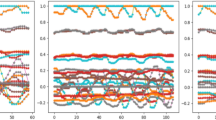Abstract
Gait recognition is important in humanitarian assistance and disaster relief (HADR) missions. It is challenging to detect human pose and recognize the gait from a drone video in distance due to low-resolution in human-figures, dynamic pose transition, and figure-to-figure and figure-to-background interaction. Conventional pose estimation methods often fail to register proper gaits from drone footages. In this study, In this study, we explore the Adaptive Pose Estimation (APE) method that incorporates drone flight data and camera pose estimation to improve the pose estimation in drone videos. We also explore the novel methods to estimate the drone camera pose with Google Earth 3D model and to reduce the “phantom poses” with “amputation filter.” Our results show that the pose estimation accuracy increases 36% and the recognition rate for six gaits reaches 91.7% on average.
Access this chapter
Tax calculation will be finalised at checkout
Purchases are for personal use only
Similar content being viewed by others
References
Bhanu, B., Han, J.: Human recognition at a distance in video. In: Advances in Pattern Recognition book series (ACVPR), Springer, New York (2010) https://doi.org/10.1007/978-0-85729-124-0
Thompson, J., Jain, A., LeCun, Y., Bregler, C.: Joint training of a convolutional network and a graphical model for human pose estimation. In: NIPS (2014)
Wikipedia. Pinhole Camera Model, captured January 19, 2021 https://en.wikipedia.org/wiki/Pinhole_camera_model
McConville, J.: Anthropometric Relationships of Body and Body Segments Moments of Inertia Anthropology Research Project, Inc. A/F Aerospace Medical Res 12–80
CsvView Website link. https://datfile.net/index.html
Olmschenk, G., Tang, H., Zhu, Z.: Pitch and Roll Camera Orientation from a Single 2D Image Using Convolutional Neural Networks. In: 2017 14th Conference on Computer and Robot Vision (CRV), Edmonton, AB, 2017, pp. 261–268. https://doi.org/10.1109/CRV.2017.53
Kendall, A., Cipolla, R.: Geometric loss functions for camera pose regression with deep learning. In: Proceedings of the IEEE Conference on Computer Vision and Pattern Recognition (CVPR) (2017)
Kendall, A., Grimes, M., Cipolla, R.: PoseNet: a convolutional network for real-time 6-DOF camera relocalization. In: Proceedings of the International Conference on Computer Vision (ICCV) (2015)
Malis, E., Vargas, M.: Deeper understanding of the homography decomposition for vision-based control. [Research Report] RR-6303, INRIA 2007, p. 90 (2007)
Cao, Z., Hidalgo, G., Simon, T., Wei, S.-E., Sheikh, Y.: OpenPose: realtime multi-person 2D pose estimation using Part Affinity Fields. arXiv preprint arXiv:1812.08008 (2018)
Oppenheim, A.V., Schafer, R.W., Buck, J.R.: Discrete-time signal processing, Prentice Hall, Upper Saddle River (1999) ISBN 0-13-754920-2
Engel, J.: Polytomous logistic regression. Stat. Neerl. 42(4), 233–252 (1988). https://doi.org/10.1111/j.1467-9574.1988.tb01238.x
Tibshirani, R.: Regression Shrinkage and Selection via the lasso. J. Royal Stat. Soc. Ser B (methodological). Wiley. 58(1): 267–88 (1996)
Friedman, J., Hastie, T., Tibshirani, R.: Regularization paths for generalized linear models via coordinate descent. J. Stat. Softw. 33(1), 1 (2010)
Acknowledgement
The author would like to thank the discussions with Scott Ledgerwood, Neta Ezer, Nick Molino, Justin Viverito, Dennis Fortner, and Mel Siegel. The author is grateful to the support from NIST PSCR and PSIAP and Northrop Grumman Corporation.
Author information
Authors and Affiliations
Corresponding author
Editor information
Editors and Affiliations
Rights and permissions
Copyright information
© 2021 The Author(s), under exclusive license to Springer Nature Switzerland AG
About this paper
Cite this paper
Cai, Y., Kiefel, J., Wu, X. (2021). Gait Recognition from Drone Videos. In: Ahram, T.Z., Falcão, C.S. (eds) Advances in Usability, User Experience, Wearable and Assistive Technology. AHFE 2021. Lecture Notes in Networks and Systems, vol 275. Springer, Cham. https://doi.org/10.1007/978-3-030-80091-8_46
Download citation
DOI: https://doi.org/10.1007/978-3-030-80091-8_46
Published:
Publisher Name: Springer, Cham
Print ISBN: 978-3-030-80090-1
Online ISBN: 978-3-030-80091-8
eBook Packages: EngineeringEngineering (R0)




